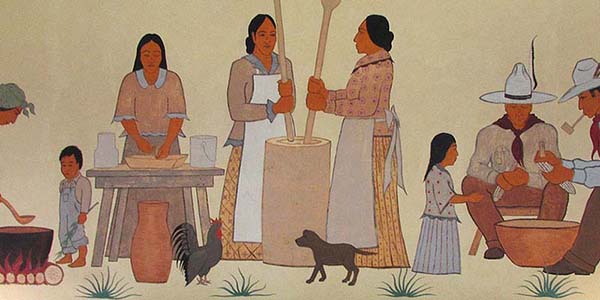November

The Great Seal of the Creek, or Muscogee, tribe has as its center a sheaf of wheat and a plow. The Creeks were agriculturalists from their earliest days. After coming to Indian Territory the Creeks grew small grains, especially wheat, oats and rice, and large crops of corn in the rich lands bordering the Canadian and Arkansas rivers and their tributaries. Their success with these crops brought prosperity to the tribe. The Green Corn Dance was celebrated in summer as a thanksgiving celebration.
Thanksgiving - Celebrating the Harvest
Before the Pilgrims had their famous Thanksgiving feast in 1621, native people all over the continent had been holding their own feasts of thanksgiving for the harvest for thousands of years.
Cherokee Farming
Students read about farming among the Cherokees and compare farming before and after the removal to Indian Territory from their home lands in the east. Students will make a timeline of the foods adopted by the Cherokee. Students will research to learn more about the Cherokee. Students will conduct experiments with heirloom seeds.
Plows on the Hunting Grounds
Students learn about the Indian Allotment Act of 1887, which paved the way for opening Indian land to homesteading.
Territorial Children
What was it like to be a child - Indian or settler - in the early days of Oklahoma Territory? Includes games played by settler children and Indian children.
Corn Then and Now
Students identify countries in South and Central America where corn originated, research the importance of corn to the suvival of early civilizations of the Americas, research and compare the myths and legends about corn and use their creative abilities to act them out.
Pashofa is a soupy dish made from cracked white corn, also known as pearl hominy. The dish is one of the most important to the Chickasaw people and has been served at ceremonial and social events for centuries. Pashofa is also used in specific healing ceremonies.
Traditionally, dried corn was ground in a mortar into cornmeal and cooked in a pot with water. Finely cut pieces of pork or beef was added. The dish was served cold and could keep up to a month.
Specialized paddles and spoons, carved from wood or animal horns, were used in stirring, serving, and eating pashofa. Pashofa was cooked in giant bowls, often over an open fire outdoors.
Books
Bruchac, Joseph, and Murv Jacob, The Circle of Thanks: Native American Poems and Songs of Thanksgiving, Troll, 2003. (Grades 1-5)
Bruchac gathers 14 traditional Native American poems of appreciation and respect for nature's gifts. It is a wide sampling, drawn from Cherokee, Kwakiutl, Pawnee, Navajo and more.
Glatzer, Jenna, Native American Festivals and Ceremonies, Mason Crest, 2002.
Describes some of the ceremonies and festivals that Native American peoples use to celebrate special occasions, give thanks, etc.
Grace, Catherine O'Neill, 1621: A New Look at Thanksgiving, National Geographic Children's, 2004. (Grades 3-5)
Well-researched account of the Wampanoag side of the Thanksgiving story. Provides background on the Wampanoag, colonization, Indian diplomacy, the harvest of 1621 and the evolution of the Thanksgiving story.
Nielsen, L. Michelle, Biography of Corn, Craptree, 2007. (Grades 4-6)
Maize, or corn, was the staple food of many early cultures in South America, Mesoamerica and the Caribbean. This book shows how the farming of corn spread to the rest of the world.
Tingle, Tim, and Jeanne Rorex Bridges, Crossing Bok Chitto: A Choctaw Tale of Friendship and Freedom, Cinco Puntos, 2006. (Grades 2-6)
In the days before the War Between the States, and the days before the Trail of Tears, a Mississippi Choctaw girl strays across the Bok Chitto River into the world of Southern Plantations where she befriends a slave boy and his family. When trouble comes, the desperate runaways flee to freedom, helped by the Choctaws' secret route across the river. Includes sophisticated end notes about Choctaw history and storytelling traditions.
Waldman, Stuart, We Asked for Nothing: The Remarkable Journey of Cabeza de Vaca, Mikaya, 2003. (Grades 4-6)
Conquistador Alvar Nunez Cabeza de Vaca and his men were shipwrecked on an island shore off the coast of Texas in 1528. Local Indians brought them food and water and cared for them. Cabeza de Vaca lived among native tribes in the Southwest for eight years as he and three others walked toward the Spanish settlements in what is now Mexico. Enduring starvation, illness, and enslavement, they survived largely through the kindness of the Indians they met along the way. A foldout map traces the journey on land and sea.


